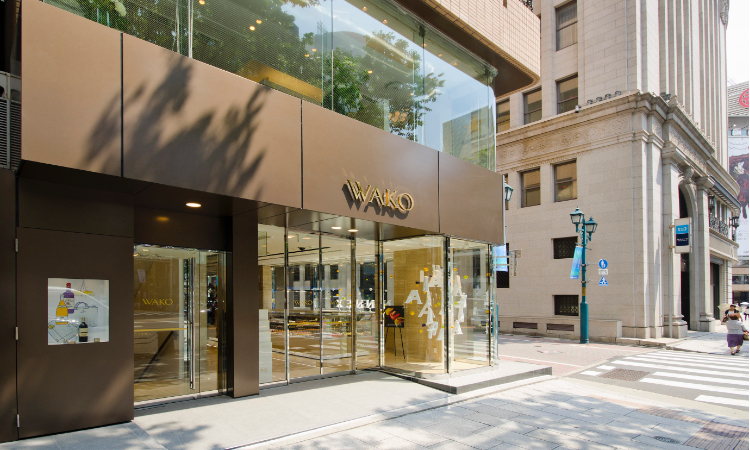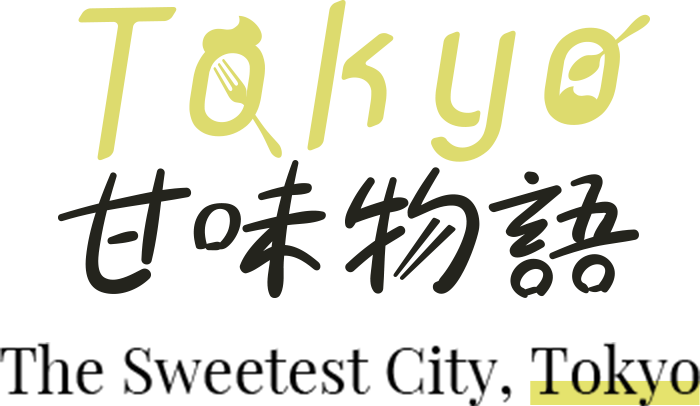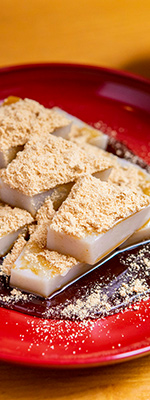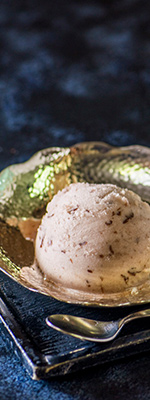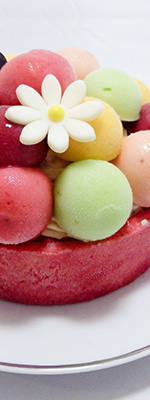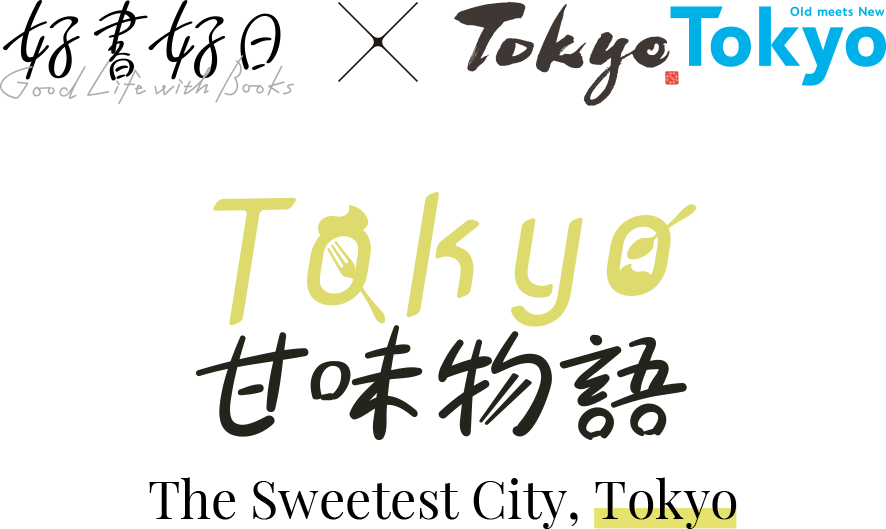
Original Confections Designed for Tokyo Tokyo
by the Prestigious Ginza-district Store WAKO!
Original Confections
Designed for Tokyo Tokyo
by the Prestigious
Ginza-district Store WAKO!
About one month has passed since two pastry chefs at WAKO, the prestigious store in Tokyo's Ginza district, completed original confections which they christened “Cake Kinako” and “Ruby Shortcake.” Both of these treats have reportedly been given high marks by many people who stroll the Ginza and drop in at the WAKO Annex Cake & Chocolate Shop, which is selling them. In Part I of this special feature, we presented everything from prototype-product tastings to final product completion. No doubt many of you are wondering how these new items taste and want to learn about them in more detail. For Part II, we therefore asked celebrity Kaori Manabe to sample Cake Kinako and Ruby Shortcake. Part II begins with commentary by the pastry chefs Takahiro Matsume and Ryohei Oguma, who were in charge of the production of these respective treats, followed by Manabe's specific remarks on their features and flavors upon actually eating them.
[Reporting and Layout: Kanako Nezu]
Kaori Manabe tried Cake Kinako!
Matsume: As the name indicates, it is a pound cake made with kinako, that is, roasted soybean flour. Pound cake has long been sold at WAKO too, and people of all ages readily become fond of it. This made me decide to use it for the base. Pound cake is a Western pastry item, and I therefore wanted to add a traditional Japanese ingredient to it. Kink came to mind. I mixed amanatto sugared beans made from white kidney beans, which are used to make shiro-an white sweet bean paste, into the cake batter. Outside Japan, I think there are few cultures that use sweetened beans to make confections, and I pictured a new type of pound cake blending Japanese and Western ingredients in the process of development.
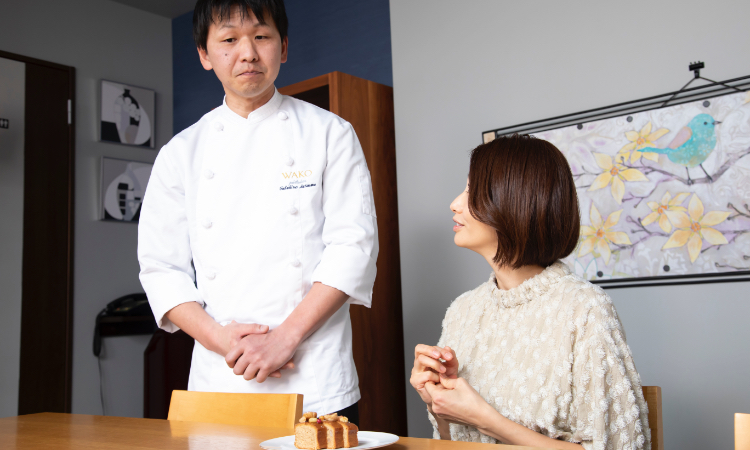
Manabe: Topped with dried figs, raisins, and other ingredients, I thought it looked wonderful. And even before taking a bite, there was a strong kinako fragrance. That surprised me. Does the cake actually contain a large amount of kinako as this suggests?
Matsume: I tried various types of kinako and chose the one with the richest fragrance for this cake. The actual content of kinako is not that high. Use of traditional Japanese ingredients is apt to make the confection look more somber. For this reason, I topped the cake with dried figs, jewelry raisins, and the red granules of framboise cereal to brighten it. Please eat the dried figs and cake together. The texture and sweetness of the dried figs go very well with the kinako cake.
Manabe: It has the gorgeous flair that pastry should have. With the kinako and white kidney beans, the cake has a gentle flavor, but the combination with the tartness of the dried figs is really exquisite. The cake, too, is not as oily as sponge cake, but still has a moist texture and crumbles in the mouth. I felt that there was a certain resemblance to Japanese confections. The texture and the flavor as well are a Japanese-Western hybrid. It is a truly novel creation. In my view, it is not just a pound cake made with Japanese ingredients.
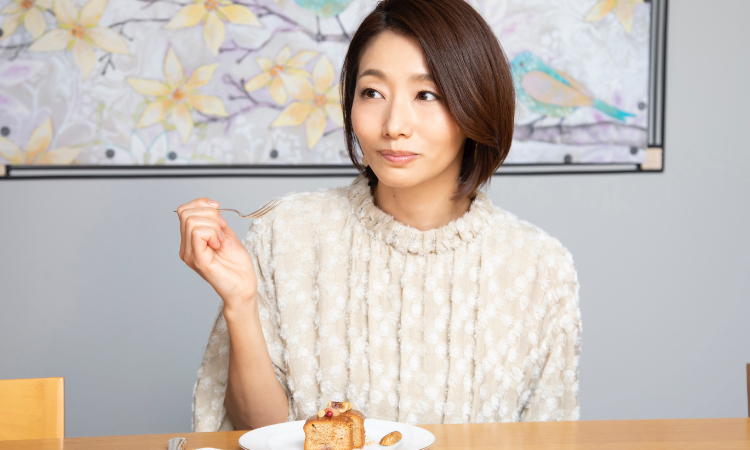
Show-business personality
Manabe: No. The use of kinako is one thing, but the cake also contains dried fruits commonly used in Western pastry, and this makes for a mild flavor with a fairly subdued sweetness. And yet each ingredient retains its unique qualities. It is indeed a marvelous cake. I sensed a little saltiness in the dried figs, and the cake consequently struck me as one for an adult palate. Because the flavor is so gentle, I think the cake could be enjoyed with a wide range of companions, meaning not only green tea, black tea, and coffee but also red wine and sake.
Matsume: I used the nappage technique to put a glaze on the cake surface. I ordinarily use ingredients such as jams for this, but I selected Mizuame (millet jelly) this time in order to accent the kinako flavor.
——I understand that the nappage also acts like an adhesive that prevents the cake topping from falling off. Little touches like this gladden the heart.
Manabe: As might be expected of a master pastry chef. This is really perfect for a gift. I would like to give one to someone at the workplace and see the surprised look on their face. I believe the taste would also delight children. The cake would be ideal for occasions that bring together both young and old, and men and women.
Kaori Manabe tried Ruby Shortcake!
——Next, I would like to ask Chef Oguma, who was in charge of Ruby Shortcake, to tell us about it.
Oguma: Hearing that the Tokyo Tokyo concept for this project is “Old meets New,” I decided to make a “shortcake of the future,” meaning one that had a new flavor and appearance while based on the traditional shortcake born in Tokyo about 100 years ago. The main ingredient is ruby chocolate, which is considered the “fourth chocolate.” Because ruby chocolate itself has a strong sweetness, I added berries for their tartness to strike a proper balance. By molding the ruby chocolate around the outside in a tubular fashion, I was able to add a variety of toppings, including strawberries, raspberries, and blueberries. I also used ingredients like puffed rice and chocolate-covered raspberries for their texture accents. On the inside, I put raspberries into the ruby chocolate cream between the shortcake sections for a more tart flavor.
Manabe: Overall, it is not too sweet and has a very clean taste. Ordinarily, shortcake is liable to feel heavier toward the end. But with Ruby Shortcake, the tartness works just right, and I could easily eat the whole thing without getting tired of the taste before finishing.
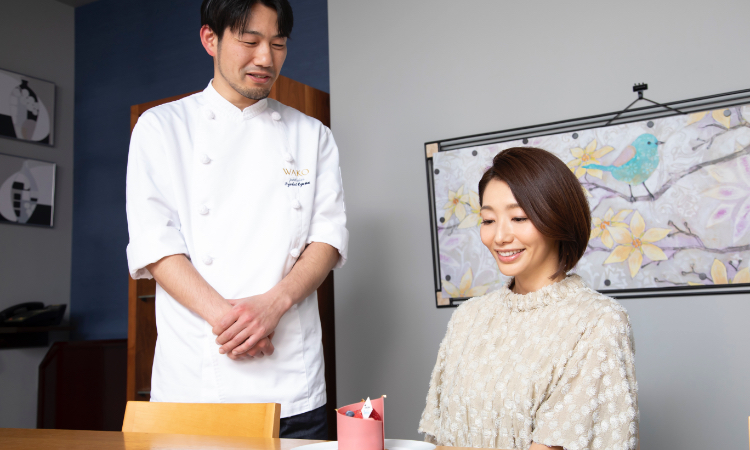
——During the photography session, you asked the chef about ruby chocolate. Did you know about it?
Manabe: Around last year, when ruby chocolate began appearing in stores, I started looking at various types. I like it so much that I constantly keep some on hand at home. But I have never seen a pastry that made such lavish use of it. While selecting ruby chocolate as the main ingredient, the chef made a point of pairing it with traditional shortcake. It struck me that Ruby Shortcake is perfectly attuned to the project concept.
Oguma: When you say “shortcake,” people usually think of a triangular or round shape. I aimed for shortcake that was unprecedented as regards shape as well as flavor. Wrapping it with chocolate made it possible to decorate it with many fruits. Make sure to eat the brittle chocolate on the outside together with the shortcake on the inside.
——It looks so pretty, and one would hesitate to cut it for fear of destroying the shape.
Manabe: That’s right. I too thought it would be hard to eat at first glance, but discovered it was easy to handle in the process. Because it is held together by the chocolate on the outside, if you keep removing the cake in the middle, it doesn't collapse at all and you can eat it neatly to the very end. The outer ruby chocolate is very tasty in itself. Then there are the tart tones, and not only from the raspberries and other berries; the ruby chocolate too has a faint tartness. Ruby Shortcake goes down extremely well.
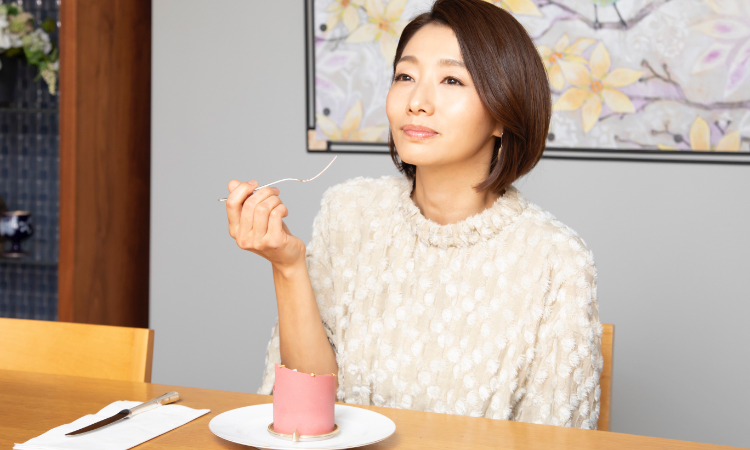
——The cake even has gold leaf on the ruby chocolate, and is really beautiful. I have rarely seen a cake with such a pretty pink color. As a woman, it gives me a thrill. For what sort of occasions would you recommend Ruby Shortcake?
Manabe: I think it would be perfect for women's get-togethers. The arrival of springs brings many treats with a pink color, and you want to make a toast with glasses of rosé champagne. A pretty pink pastry like this would surely add a gala flair to a gathering of mothers of children in the same school or a party in the home.
Ms. Manabe
——From here on, I would like to ask Ms. Manabe to talk about her memories of Tokyo confections. I understand that you were born in Ehime Prefecture. Were there any Tokyo foods that you longed to try?
Goodness, I had a longing for all kinds of Tokyo foods! Take pasta, for example. While I lived in Ehime, I knew of only about three types, one being Neapolitan. But when I came to Tokyo, I was stunned to learn of the existence of pasta in a cream sauce made with sea urchin eggs (laughter). Oh, I just remembered; I'm sure you know the cute tart covered with plenty of fruit that is sold by Qu'il fait bon, for example. But in my native Ehime, “tart” means that sold by Ichiroku.
——Ichiroku tart! Yes, I know it. It's a confection made by rolling sweet bean paste in sponge cake, and has a hint of a citron scent. I like it too.
You know it!? That makes me happy! I always identified that item with “tart”. So when I first saw the cake they call “tart” in Tokyo, I was amazed. “But it's not rolled!” I thought (laughter).
——Even though the name is the same. It is strange.
This was before Qu'il fait bon became so popular, and there were not many sweets in the form of tart topped with plenty of fruit. For this reason, I have still not forgotten the jolt I got when I first saw the tart they sell in the department store basements of Tokyo's Shibuya district. Even now, I can clearly remember thinking, “Just what kind of tart is that!?”
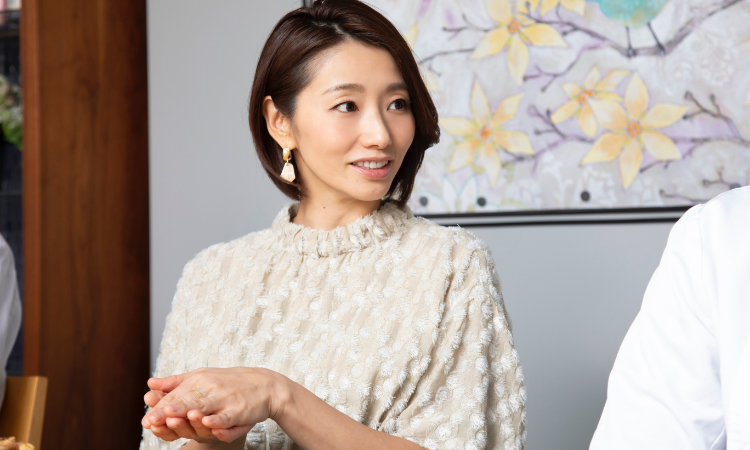
——I can see that, for you, Tokyo is a place that offers many exciting encounters. What image does “Tokyo sweets” conjure up in your mind?
I would say “marvel and excitement.” Nearly 20 years have passed since I came to Tokyo, but I still discover many exciting foods, and the marvels of this city seem to be infinite. It is true that other cities each have their own excellent foods making use of local ingredients and foodstuffs. But to me, things such as a newness never before experienced and sense of marvel and excitement tasted in foods are distinctly Tokyo. I have now lived in Tokyo for a long time, but still encounter things that are new to me and give me a thrill, and that is really a joy.
——Were you able to feel that distinctive Tokyo charm from the Cake Kinako and Ruby Shortcake you ate today?
Yes! With Cake Kinako, I was moved by the exquisite harmonization of the kinako and white kidney beans with a Western pastry item. Pound cake is a little heavier, but Cake Kinako had both the plainness of Japanese confections and the edge of Western pastry. The balance between the two was wonderful. I was astounded to learn we have reached the point where such items are no longer mere pairings of Japanese and Western ingredients.
The same applies for Ruby Shortcake. It looked so pretty, and I wondered how it tasted. But when I took a bite, it had the unmistakable flavor of shortcake. This was complemented by the tartness and juiciness of the fruit. It was the first time that a shortcake went down so easily for me, right to the last forkful. Both were completely new flavor experiences for me and very exciting. That's what made them seem distinctly Tokyo in my eyes.
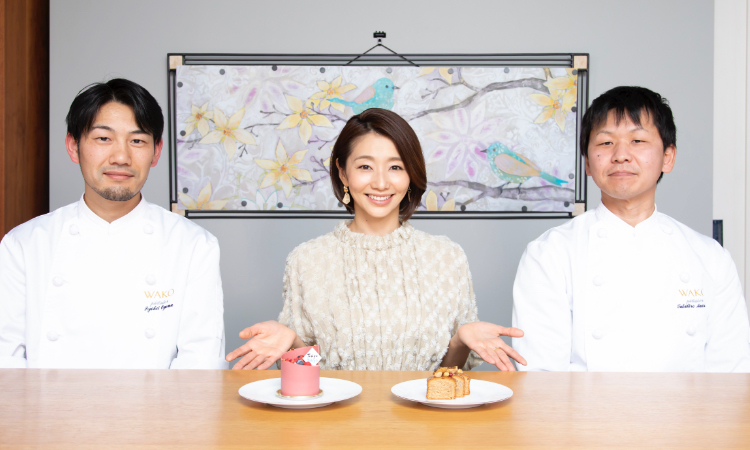
Kaori Manabe/Show-business personality. Born in Ehime Prefecture in 1980, Kaori Manabe is a graduate of Yokohama National University. She began show-business activities in her university days, and is currently active in multiple genres. More specifically, besides appearing on TV variety show programs, she serves as a commentator on news and information programs, appears on TV commercials, and is an author.
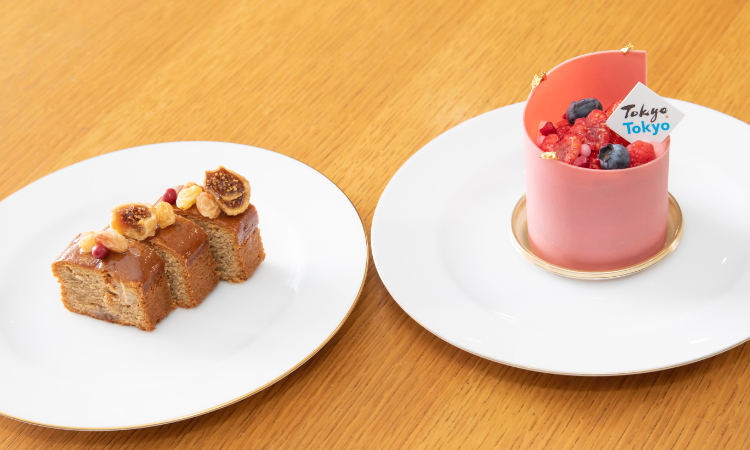
In addition to Cake Kinako (¥2,000 before tax) and Ruby Shortcake (¥800 before tax), the new product St-Honoré Ruby (¥750 before tax) made its debut on Saturday, February 15 at WAKO Annex's first-floor Cake and Chocolate Shop. This innovative take on the St. Honoré cake, a traditional French confection made with choux pastry batter, features the same cream as that used in the Ruby Shortcake. These new treats are sure to become big hits in Tokyo, so please come down to WAKO Annex and try them for yourself!
Cake and Chocolate Shop
[Location] WAKO Annex 1st floor, 4-4-8 Ginza, Chuo-ku, Tokyo
[TEL] 03-5250-3102
[Business hours/fixed holidays]
10:30 a.m.–7:30 p.m. (closes at 7:00 p.m. on Sun. and holidays), open year round
[Official site]
https://www.wako.co.jp/store_information/main/annex/index.html
